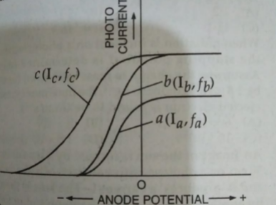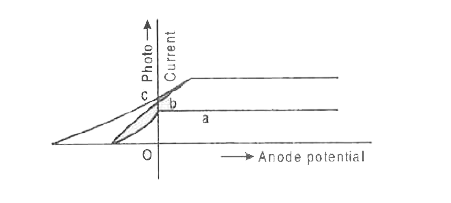The figrue shows the variation of photocurrent with anode potential for a photo-sensitive surface for three differenct radiationslLet Ia,Ib and I be the intensitite snd fa,fb and fc be the frequencies for the curves a,b and c respectrively.
 .Solution in Punjabi
.Solution in Punjabi
fa=fb and Ia=Ic
fa=fc and Ia=Ic
fa=fb and Ia=Ib
fb=fc and Ib=Ic.
Step by step video & image solution for The figrue shows the variation of photocurrent with anode potential for a photo-sensitive surface for three differenct radiationslLet I_a,I_b and I_cc be the intensitite snd f_a,f_b and f_c be the frequencies for the curves a,b and c respectrively.. by Physics experts to help you in doubts & scoring excellent marks in Class 12 exams.
Updated on:21/07/2023Topper's Solved these Questions
Similar Questions
The photon of frequency v has a momntum associated with it .If c is the velocity of light,then momentum is
View SolutionTo get five images of a single object, one should have two plane mirrors at an angle of :
View SolutionProve that electromagnetic waves are transverse in nature.
View SolutionThree identical cars A,B and C are moving at the same speed on three bridges. The car A goes on a plane bridge, B on a bridge convex upward and C goes on a bridge concave upward. Let FA,FBandFC be the normal forces exerted by the cars on the bridges when they are at the middle of bridges
View SolutionThe figure shows the variation of photocurrent with anode potential for a photosensitve surface for three different radiations. Let la,lbandlc be the curves a, b and c, respectively

(a) fa=fbandla≠lb (b) fa=fcandla=lc
(c ) fa=fbandla=lb (d) fb=fcandlb=lc
View SolutionThe Fig shows a plot of three curves a, b, c showing the variation of photocurrent versis collector plate potential for the different intensities I_1, I_2 and I_3 having frequencies v_1, v_2 and v_3 respectively, incident on a photosensitive surface. Point out the two curves for which the incident radiation have same frequency but different intensities.
View SolutionThe fig. shows the variation of photon current with anode potential for a photo-sensitive surface for three different radiation. Let Ia,IbandIc be the intensities and fa,fbandfc be the frequency for the curves a,b and c respectively.

View SolutionThe figures shows th variation of photocurrent i with anode potential V for three differential radiations. Let I_(a)I_(b)" and " I_(c) be the intensities and f_(a),f_(b)" and " f_(c) be the frequencies for the curves a, b and c respectively . Then
View SolutionFig. shows variation of photocurrent with anode potential for photosensitive surface for three different radiations. Let Ia,Ib and Ic be the intensities and fa,fb and fc the frequencies for curves a, b to c, then:

View SolutionIn the following figure shows the variation of photocurrent with potential of the collector plate for a photosensitive surface for three different radiations. Let Ia,IbandIc be the intensities and fa,fbandfc be the frequencies for the curves a, b, and c, respectively.

View SolutionThree identical cars A,B and C are moving at the same speed on three bridges. The car A goes on a plane bridge, B on a bridge convex upward and C goes on a bridge concave upward. Let FA,FBandFC be the normal forces exerted by the cars on the bridges when they are at the middle of bridges
View SolutionThe fig. shows the variation of photon current with anode potential for a photo-sensitive surface for three different radiation. Let Ia,IbandIc be the intensities and fa,fbandfc be the frequency for the curves a,b and c respectively.

View SolutionThe moments of inertia of two rotating bodies A and B are I_A and I_B(I_A gt I_B) . If their angular momenta are equal then.
View SolutionF_c and F_A denote cohesive and adhesive forces on a liquid molecule near the surface of a solid. The surface of liquid is convex , if
View SolutionThe figure shows the variation of photocurrent with anode potential for a photosensitve surface for three different radiations. Let la,lbandlc be the curves a, b and c, respectively

(a) fa=fbandla≠lb (b) fa=fcandla=lc
(c ) fa=fbandla=lb (d) fb=fcandlb=lc
View SolutionLight of frequency 1.5 times the threshold frequency is incident on photo-sensitive material. If the frequency is halved and intensity is doubled, the photocurrent becomes
View Solution
